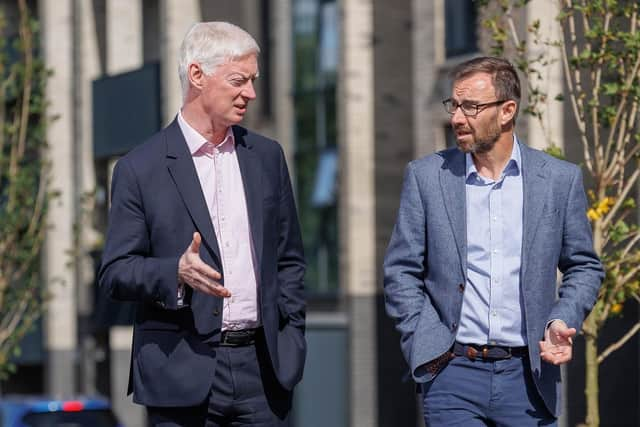The Scottish National Investment Bank – delivering impact for Scotland, says CEO


The Scottish National Investment Bank was established in 2020 by Scottish Ministers. We are a mission-led development bank for Scotland. All our investments must meet the aims of at least one of our three key missions – to grow a fairer, more sustainable economy and society through the journey to net zero; to scale-up innovation and technology, building a more competitive and productive economy; to transform communities, making them places where everyone thrives.
As we approach our third anniversary, a lot has been achieved for a start-up, and we have ever more clarity over the positive difference we can make. We have made 29 investments, committing almost £460 million of our own capital which has in turn enabled over £750m from other investors to be committed alongside us. That’s over £1.2 billion committed to the Scottish economy in nearly three years.
While we are a development bank we do invest on commercial terms, and do so as an impact investor. So what is an ‘impact investor’ when compared to other models of investing? Where traditional models of investment are focused primarily on generating strong commercial returns, in recent years we have seen a growing demand for investments that meet rigorous ESG standards. ESG stands for environmental, social, and governance standards, all key ‘non-financial’ risk areas. Applying these criteria help investors select investments that as a minimum ‘do no harm’ to the world and at best improve society and the environment.


Impact investing takes that one step further. It’s a simple idea; by using capital as a tool to create positive, demonstrable, social or environmental change while still generating positive financial returns. I believe that the nature of the challenges we must address across the economy, environment and in society means the financial system needs to try and do more to disrupt and scale change, to meet both the urgency and the scale of challenge – to not just be aware of non-financial risks (as in traditional ESG) to develop a better investment case, but to actively aim to maximise positive impact.
There’s a role for every actor in the financial system – for example, insurance and pension funds and commercial banks supporting infrastructure change at scale, or helping SMEs to transition their business models. And there’s a particular and important role for impact investing – and especially a development bank like ourselves – to help prove new technologies and ways of doing business, acting as a catalyst to drive measurable change. We are fortunate to be operating within a wider ecosystem spanning financial services, energy, universities and technology that provides huge potential for investible solutions.
As part of our disciplined investment process, businesses and projects need to prove what impact they can deliver. This is something we’ve committed to track and report on.
These can be measures such as ensuring businesses support the Scottish Government’s Fair Work First Principles so all permanent employees are paid at least the Real Living Wage, supporting our investees to develop Carbon Management Plans to help deliver Scotland’s net zero ambitions, and encouraging greater equality, diversity and inclusion in the workforce.


Our typical investments are between £1m and £50m, via debt or equity, or in helping to establish funds that align to our missions. Our role goes beyond investing the public capital we are allocated by the Scottish Government, and is also to attract in capital from third parties, typically the private sector.
Story so far
Net zero:
– £35m to support Port of Aberdeen’s expansion - better serve the offshore wind sector
– £50m North Star renewables – build service operations to service the renewables sector
– £6.6m Verlume – innovative undersea battery storage technology
Place:
– £20m / £20m follow-on for Lothian Broadband – bringing ultra-fast broadband to remote communities
– £40m to Thriving Investments – building affordable mid-market homes for rent
– £6.95 m to Highland Coast Hotels – supporting tourism and employment opportunities around the North Coast 500 route
Innovation:
– £17.8m Orbex – orbital launch business serving the small satellite industry
– £3.5m in Elasmogen – protein therapeutics company developing technology for cancer and auto-immune therapies
– £2.6m in Cyacomb – software that helps detect child sexual abuse images in a matter of seconds on hard drives of suspects, instead of taking months.
Because we invest on commercial terms, in the long-term that will enable us to become financially self-sustaining, no longer dependent on public funding, to create a perpetual investment fund on behalf of the people of Scotland.
We have a huge and current economic opportunity in our offshore wind supply chain where we can invest alongside private capital and so build the much-needed infrastructure to realise this prospect.
We welcomed £25 million of additional capital that the Scottish Government allocated to us from their Just Transition Fund to invest in this Financial Year. Additionally, the recent announcement of a further £500million to be delivered over the next 5 years between us and the government’s agencies brings even greater opportunity for ScotWind and the services that support it. We want to help create more good quality, well-paid jobs with a diverse workforce in Scotland, and recognise the knowledge gained through our oil and gas industries and how this can be leveraged as we transition to cleaner, sustainable energies of the future.
The Bank has a huge role to play in helping Scotland’s businesses grow to that next level, to become employers of the future and create change that leaves a legacy for generations to come. I firmly believe that by delivering on the missions we can generate great social, environmental and economic returns for the people of Scotland and in the process become one of the most respected impact investors in the industry.
Find out more about the Bank here: Delivering patient, mission-impact investment to the Scottish economy | Scottish National Investment Bank (thebank.scot)
Learn more about our portfolio: Investment Portfolio | Scottish National Investment Bank (thebank.scot)